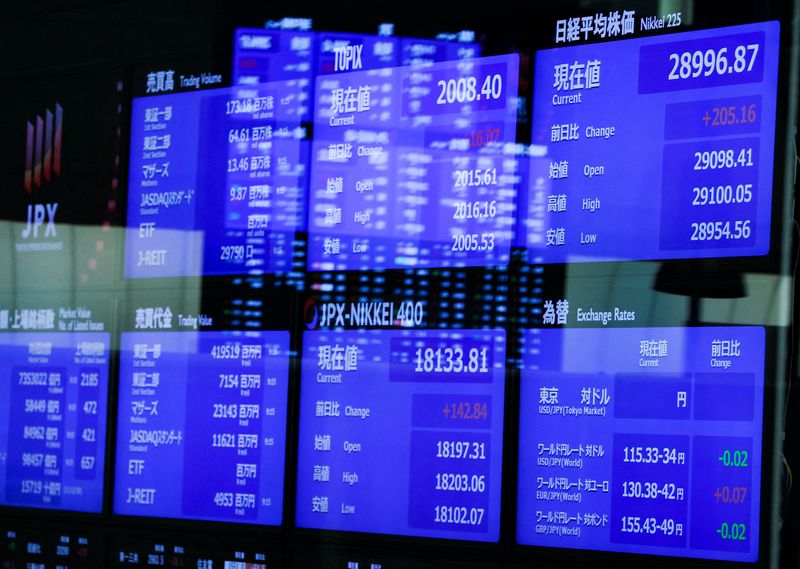
By Ray Wee
SINGAPORE (Reuters) – Asian stocks started the year poorly on Thursday as they struggled for momentum after a tense approach to 2024, while the U.S. dollar rose and investor sentiment remained cautious ahead of Donald Trump's return to the White House.
The start of the new year was looking less favorable for stocks, as uncertainty over incoming US President Trump's policies and the Federal Reserve's more hawkish outlook looked set to dominate market discourse for the time being.
While global stocks concluded 2024 with strong annual gains of nearly 16%, they posted a monthly loss of more than 2% in December.
The same was the case for MSCI's broadest index of Asia-Pacific shares outside Japan, which fell 1.2% in December despite posting gains of more than 7% for 2024.
The index fell 0.5% in the early Asian session on Thursday, with trading volume declining due to a trading holiday in Japan.
“I think we are now in a twilight zone between now and January 20,” said Tony Sycamore, market analyst at IG.
Trump is scheduled to be sworn in as President of the United States next January 20, for his second term.
“It's unusual for stocks not to see positivity in December…and that worries me a little bit, because when markets don't rise at times like this when they should, it generally means there are other concerns,” Sycamore said.
“There's pretty much a shared consensus that Trump is going to run the economy very hard.”
Chinese stocks were similarly lower at the open, with the blue-chip index falling 1.43% while the index lost 1%.
The Hong Kong index fell by 1.74%.
Investors are closely watching China's economy recover in 2025 after officials pledged a raft of support measures to boost growth, although Trump's talk of tariffs of more than 60% on imports of Chinese goods could pose a significant headwind.
“To avoid a further material slowdown as domestic hurdles and external pressures increase, China will remain heavily dependent on policy support,” said Yingrui Wang, China emerging markets economist at AXA Investment Managers.
“With Donald Trump’s return to the White House amplifying external risks and an already fragile domestic economy, a debt trap and generational deflation could be dangerously imminent if upcoming stimulus measures are delayed or misdirected.”
Elsewhere, South Korea's index fell 0.07%. The index was the worst performer in Asia in 2024, losing more than 22% in dollar terms, partly due to the deepening political crisis.
The dollar is shining
All this global uncertainty, coupled with expectations of lower Fed rate cuts this year, left the safe-haven dollar ahead on Thursday.
The large interest rate differential between the United States and other economies has cast a shadow over the foreign exchange market, causing most currencies to fall sharply against the dollar in 2024.
The dollar rose 0.3 percent in the latest trading to 157.43 yen, prompting the Japanese currency to slide towards its lowest level in more than five months.
The euro rose 0.06 percent to $1.0360, but was not far from the lowest level in more than a month, while the British pound fell 0.03 percent to $1.2522.
Markets are now pricing in interest rate cuts of around 42 basis points from the Fed this year, compared to more than 100 basis points from the European Central Bank and 60 basis points from the Bank of England.
“We now expect the Fed to make just two 25 basis point cuts in 2025 by skipping the cuts in January and May, and instead cutting in March and possibly June,” said Eli Lee, chief investment strategist at the Bank of Singapore.
Cash trading in US Treasuries was closed on Thursday due to the Japanese market holiday, but futures pointed to a rise in yields. Yields rise when bond prices fall.
“We see further upward pressure on longer-term US Treasury yields and have expectations for a 12-month US Treasury yield of 5.00%,” Lee said.

In commodities, oil prices rose on Thursday, with futures up 0.56% to $75.06 per barrel. US West Texas Intermediate crude gained 0.6 percent to $72.15.
It traded 0.4% higher at $2,634.77 an ounce. The yellow metal had a banner year in 2024, rising more than 27% in its biggest annual gain since 2010.






